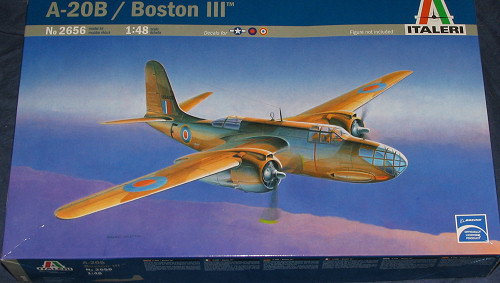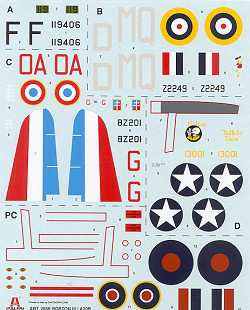
| KIT: | Italeri 1/48 A-20B/ Boston III |
| KIT #: | 2656 |
| PRICE: | $44.00 MSRP |
| DECALS: | Four options |
| REVIEWER: | Scott Van Aken |
| NOTES: | Reissue of an AMT/ERTL kit |

| HISTORY |
The Douglas DB-7/A-20 Havoc was the most-produced attack bomber during World War II (those about to argue that the Ju-87 was produced in more numbers will have to remember that it was a dive bomber. Those going for the IL-2 to have those honors are probably right. I'm just quoting from Boeing. Ed). A total of 7,477 DB-7/A-20s were built, most at Douglas, although 380 were built at the Boeing plant in Seattle, Wash. The Havoc was a mid-wing, twin-engine, three-place medium bomber that earned a reputation for getting its crews home, even when both crew and aircraft suffered crippling blows. It was called the "Boston" when it was built for England's Royal Air Force.
It entered production when, despite official neutrality in 1938, there was little doubt in the United States that the country should support its allies, Britain and France. The French saw the secret bomber project at the Douglas Santa Monica, Calif., facility and ordered the first 107 DB-7s; they were to be delivered to the French Purchasing Commission at Santa Monica starting in October, with deliveries made by ship to Casablanca. The French then ordered another 270 DB-7s. Before the fall of France in June 1940, half had been accepted, but many were still en route. Sixteen had been diverted to Belgium's Aviation Militaire.
The United Kingdom took over 162 of the DB-7s intended for France as well as Belgium, which also had fallen. By the time the United States entered World War II at the end of 1941, British Havocs and Bostons had already performed well for most of the year against German targets in North Africa and Southern Europe. The U.S. Army Air Corps designated the plane the A-20 Havoc, and it served in every theater of the war.
More than half of the DB-7/A-20s built went into service in other countries, predominantly the Soviet Union. Versions also included the F-3 photo reconnaissance aircraft and the P-70 night fighter.
| THE KIT |
 Originally produced by AMT/ERTL to much fan-fare and
the delight of thousands of modelers, this kit disappeared once Racing Champions
took over, as they had no interest in aircraft and only wanted ERTL's die-cast
line. Though it received the same level of bashing that every kit seems to be
given, it really is a fine reproduction. The general fit of the kit is very good
and there are only a few items that the modeler may want to replace, the first
one being the wheels. The tread is very oddly molded as overlapping plates and
not grooved at all. Fortunately, True Details has a fine set of replacements
that includes the life raft that goes in the empty space behind the pilot.
Originally produced by AMT/ERTL to much fan-fare and
the delight of thousands of modelers, this kit disappeared once Racing Champions
took over, as they had no interest in aircraft and only wanted ERTL's die-cast
line. Though it received the same level of bashing that every kit seems to be
given, it really is a fine reproduction. The general fit of the kit is very good
and there are only a few items that the modeler may want to replace, the first
one being the wheels. The tread is very oddly molded as overlapping plates and
not grooved at all. Fortunately, True Details has a fine set of replacements
that includes the life raft that goes in the empty space behind the pilot.
The cockpit builds up well and has side panel detail and a fairly well done seat. The separate gunner's position has a semi-scarff ring mount and there is some detail in the bombardier's section, which consists of a seating pad and bomb sight. The kit can be built with the bomb bay open, in which case one gets four bombs on a rectangular support that just fit in the opening. No racks or any other detail in the bay. Most build this with the doors closed. A nice touch is a wing spar to help hold up the wings.
There are two separate nose sections, one which is
'stepped' for the Boston III and the other which isn't for the A-20B version.
The aft gunner's position can have either single or double rear guns depending
on the version being built. The rear canopy can be open or closed. From the look
of things, if closed, you can't fit the guns. A fiddly looking but quite strong
main gear fits into the wings and then the nacelles are closed around them. This
really is the best way to go on these as fitting the gear in later is not the
easiest. You could leave off the main gear leg until after pai nting.
The engines are convincing enough and you are given the option to add on a long
range belly tank, though this prevents the bay from opening and so wouldn't
normally be carried. If doing the Boston III, there are 'cheek' guns that you
can put in place. Since this has a glass nose, finding areas for nose weight
will be a bit of a challenge, but I've seen them standing on their own so it
can't be impossible.
nting.
The engines are convincing enough and you are given the option to add on a long
range belly tank, though this prevents the bay from opening and so wouldn't
normally be carried. If doing the Boston III, there are 'cheek' guns that you
can put in place. Since this has a glass nose, finding areas for nose weight
will be a bit of a challenge, but I've seen them standing on their own so it
can't be impossible.
Italeri has gone to a booklet format for its instructions and I think this is a positive move forward. The older instructions could be a real chore to find things in with the constant folding and refolding of paper to get things like painting instructions. The usual Model Master references are given with generic color information as well. Markings are for four aircraft. The first RAF Boston III is from an unknown unit in Dark Earth/Middlestone over Azure Blue as flown in Tunisia during 1943. The second RAF bird is in the Temperate scheme of Dark Earth/Dark Green over Sky as flown by 226 Sq in April 1942. A free French aircraft is next in OD over Medium Grey (surely they mean Neutral Grey). This one has invasion stripes on the wings and the fuselage. These will have to be painted on and should be 9mm wide according to the instructions. The lone A-20B is OD/Sand upper with Medium Grey (again, it is probably Neutral Grey) undersides as flown by the 47th BG in Algeria during Feb 1943. The decals are very well printed and included data markings and the upper wing walk areas as well.
| CONCLUSIONS |
It is nice to see this kit back in circulation. It does build into a very nice model and with only a tad bit of additional help (like new wheels and perhaps some seat belts), can be made into a real winner.
| REFERENCES |
Thanks to
If you would like your product reviewed fairly and quickly by a
site that has over 300,000 visitors a month, please
contact
me or see other details in the
Note to
Contributors. and DLV Company
for the review kit. You can find Italeri kits at your favorite hobby shop
or on-line at
www.testors.com
and DLV Company
for the review kit. You can find Italeri kits at your favorite hobby shop
or on-line at
www.testors.com